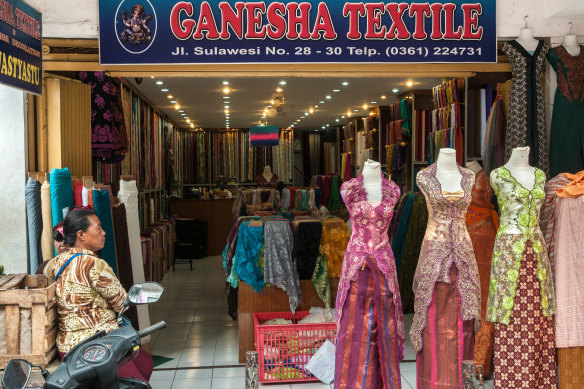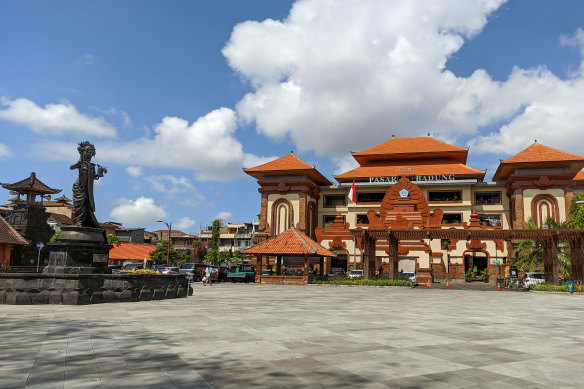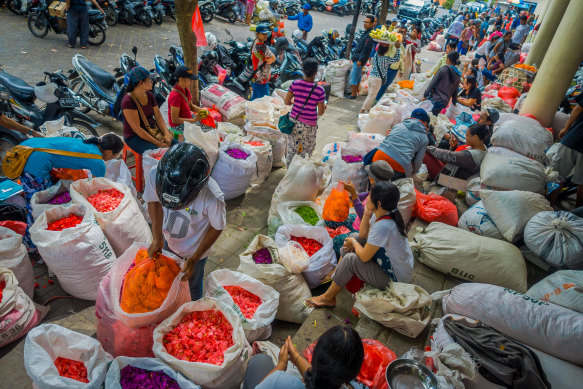Opinion
The Bali town every Australian knows, but few ever actually visit
Michael Veitch
Author, actor and broadcasterOn busy Gajah Mada Street, the lino floor of the Bhineka Djaja cafe is lifting a little, and fading faces gaze out from framed photographs and yellowing newspaper cuttings hung a little crookedly across the wood-panelled walls. I try reading them, but they’re all in Indonesian.
Across from me at a small round table sits a lean, handsome man of maybe 60 with a magnificent dark mane and a red kerchief knotted at his neck. His companion, equally striking with perfect crimson lipstick, sips occasionally at her short black coffee. The two of them smoke and laugh, oblivious to the noise and traffic of the hot Balinese afternoon beyond the large entrance. Academics, perhaps, I wonder. They look in my direction and smile.

A textile shop in Denpasar’s Sulawesi Street.Credit: Alamy
A long-time lover of Bali, I had seen the inside of plenty of her hundreds of cafes over the years, but nothing like the gently ageing beauty of this one. Then again, I’d never really seen Denpasar. Not many visitors have.
No one would ever mistake Bali’s capital for a pretty town but, as I discovered, Denpasar clings to its own unexpected charm of narrow streets, small local markets and rows of shops where time seems to have long ago ground to a halt and there are almost no tourists.
I turn left down beside the enormous Badung Market (Denpasar in fact translates as Market Town) housed inside what looks like a vast bunker or multi-level car park, make my way down Sulawesi Street, and merge into a forest of vivid colour. I am in the textile quarter where dozens of small family-run shops display fabrics of every shade and texture, contrasting with the mildewing concrete of the building above.

Pasar Badung market.Credit: iStock
Over every shop is an old painted sign – each a variation on the other – spelling out names like Cendana Textiel, Narmada and Toko Anda. The interiors are a maze of hundreds of bolts of cloth that the proprietors will retrieve at the slightest sign of interest. Otherwise, they sit with their children on the front step, chatting to the owner of the identical establishment beside them. I step my way past, feeling a little like an intruder. Some offer a hello; others stare blank-faced. A schoolgirl in uniform nudges her friend who looks up and ignores me completely. Some of the places are closed, guarded by the sort of old and elaborately worked steel shutters that have disappeared from almost every other part of the island.
My guide, Wayan, has brought me into the centre of Denpasar after I had asked what, if anything, remains of the “Old Bali”. Like almost every other private driver, Wayan spends his days collecting tourists from the shiny new arrivals hall just down the road at Ngurah Rai International Airport, before whisking them up to the busy hubs of Kuta, Ubud and beyond. When leaving the airport, his car – like thousands of others – will veer to the left or to the right of Denpasar, bypassing it completely, as if following the line of some invisible frontier rarely crossed by tourists.
I could see it, or rather sense it, on the drive in – the gradual dropping away of the hotels, and fewer tourists on the streets. Then, without realising it, we were in the city which bustled along for no one but the locals.
Wayan walks with me, but not too close, letting me take it in, intrigued at my fascination for this secret city hiding in plain sight. We turn a corner and we’re in a market. It’s one of the small specialist markets selling little else but ceremonial flowers – great sacks of blue and yellow and purple – and piles of uncut reeds ready to be made into the little offerings dishes that appear at dawn in every corner of Bali. At my prompting, Wayan asks a question or two of some vendors, then recommends I stop next to a cart selling bolen pisang – a local delicacy of cheese, chocolate and banana cooked in puff pastry. It is utterly delicious and I’ve never seen it anywhere else.
Then I spot him – virtually the only other Westerner of the day – a grizzled older man in denim and a grey ponytail who moves like a slow ship. He passes close by, but his eyes remain fixed ahead. The sort of fella, I imagine, who found himself washed up here one day long ago, and has no intention of being discovered.

Local colour at the flower markets.Credit: Alamy
Around the corner, another market. This one selling all sorts of live animals – fish, large lizards and myriad birds in cages which seem far too small. I have no wish to linger here.
At a nearby warung, or restaurant, Wayan and I eat a rice and chicken lunch on red vinyl seats and linoleum tables. “This place is famous”, he says looking around, “but... not so much with the tourists”. On my phone I zoom in on the surrounding streetscape, but it makes little sense. “Where’s the centre?” I ask. “Oh,” says Wayan gesturing somewhere over his shoulder, “I’ll take you.” I ask the owner how long the restaurant has been here – “1960s, I think,” he says. Checking again, my map tells me that the throbbing beach hub of Seminyak is just five kilometres from where we sit.
Kartini Street seems to be reserved for the hardware shops, and almost all are devoid of people. Some display rows of foot-pedalled cast-iron Singer sewing machines in their shiny black lacquer livery. Ancient, yet brand new.
Next door the Semangat Baru sells everything from men’s shirts still in their timeworn packets to an assortment of electrical goods. This shop, too, appears empty, but suddenly an old man emerges from somewhere and positions himself behind the counter. I pick out a little portable shaving kit. He reaches into a box and adds a small packet of safety razor blades, the type I watched my father use.
The man is friendly and tells me he is 75, and that his wife died 10 years ago. He inherited this shop from his father, who set it up after emigrating from Hong Kong in 1952. He is happy to pose for a photo and stands in front of a large glass cabinet holding ghetto blaster tape players from the ’80s, all still in their boxes.
“Come and see the movie theatre”, Wayan suggests. A short walk and an escalator ride leads up to the Denpasar Cineplex which, with its amber lighting and multicoloured carpet looks virtually unchanged from when it was installed, presumably decades ago. It is clean and air-conditioned and busy with groups of excited young people queuing for tickets and ice creams.
“Maybe time for the museum”, advises my guide, “before it gets too hot”. Too late for that, I’m afraid.
We take a long walk and emerge beside a large open park, the site of the infamous 1906 Badang Puputan. Here, the monument tells me, the king and his followers emerged from the old royal palace to confront the conquering Dutch army and, rather than be subjugated, drew their kris, or sacred daggers, and killed themselves en masse, the noble women tossing their jewellery towards the Dutch in defiant mockery. Up to 2000 people, it is believed, died here.
Inside the palace itself, I am drenched in sweat and the museum turns out to be completely inadequate – just a collection of loosely labelled artefacts with little context. One of the uniformed attendants, however, so impressed to see a foreign visitor, asks to pose beside me for a photo.
Last stop, past some imposing Suharto-era government buildings including an enormous but strangely empty old bank, is Bali’s first ever hotel, now called the Heritage, built by the victorious Dutch in 1928 and in continuous use since, including by the occupying Japanese during the Second World War. I take in just the reception and its high deco ceiling, but most of the original fittings seem to have been removed. As I leave, the man behind the desk comes out and hands me a hotel card.
Sure enough, a few kilometres into the drive back to my resort at busy Sanur Beach, the shiny malls and supermarkets begin to reappear, then the tourist infrastructure. Wayan drops me off and waves goodbye. He has shown me exactly what I wanted to see, even though he can’t quite grasp why I wanted to see it.
Feeling like the child who’d found the door into the secret garden, I recount my day to the concierge. He listens and smiles in that wonderful Balinese way, but looks at me quizzically.
“You … went into Denpasar …?” is all he says.
Sign up for the Traveller Deals newsletter
Get exclusive travel deals delivered straight to your inbox. Sign up now.